Cold emailing is the most effective and inexpensive channel to generate new leads. But when you send cold emails on a large scale, there are a few potential pitfalls.
If you use bulk email marketing tools (such as Mailchimp) to send thousands of cold emails on a daily basis, not only will the majority of your emails end up in the SPAM folder, but your email sending account will be blacklisted and all future emails will also end up in the SPAM folder.
That’s why you need to exercise a certain degree of care when using cold emails for lead generation.
Now, we’ll look at the best practices for cold email writing, running cold email marketing campaigns at scale, and getting people to read and respond to your cold emails.
Table of Contents
1. Best practices for cold email marketing
1.1 Build up and maintain healthy sender reputation
1.2 Build your mailing lists organically
1.3 Verify your mailing lists
1.4 Use a cold email marketing software
1.5 Mitigate risks by using separate domain for email marketing
2. Tips and tactics for writing cold emails
2.1 Subject line
2.2 Cold email content
2.3 Add a personalized touch to your emails
2.4 Highlight experience, build trust
2.5 Focus on value, not on features
2.6 Clear ‘call to action’
2.7 Warm up email account and test deliverability
Best practices for cold email marketing
Cold email marketing differs from bulk email marketing in that you send cold emails to people who have never heard from you before, as opposed to sending marketing emails to people who have subscribed to your newsletter.
If you use a regular email marketing software to send cold emails in bulk, most of them will getting trapped .
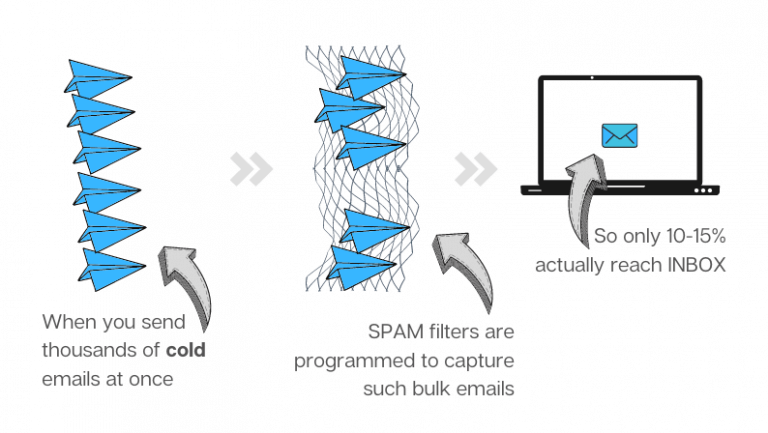
Your email account must have a high sender reputation in order to avoid spam filters. Furthermore, SPAM filters will classify your behaviour as spamming if it appears that you are using a software to send emails to strangers.
But if it appears that you are manually sending personalised cold emails, spam filters will allow them to pass.
Keeping these considerations in mind, let’s take a look at some practical steps you can take to improve the deliverability of your cold emails.
Build up and maintain healthy sender reputation
First and foremost, you must ensure that your email account has a positive sender reputation or sender score. You can use these tools to check your sender score.
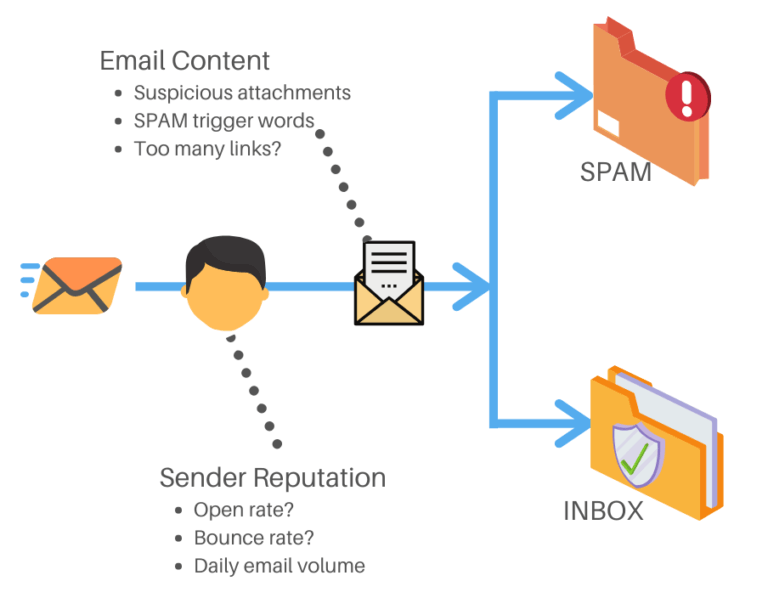
If you create a new domain or email account, it will have no sender reputation at first. Before you can start sending hundreds of cold emails per day, you must first establish a solid sender reputation. Otherwise, if you send a few thousand emails in your first week and many of them go unnoticed, your sender reputation will suffer greatly.
However, by gradually warming up your new email account, you can steadily improve your sender reputation. You can accomplish this by first sending a small number of cold emails and gradually increasing the email volume. It also helps if your email account receives a significant amount of incoming traffic. You can keep it up by signing up for a bunch of valuable newsletters.
Here’s a more detailed guide on how to warm up your new email account.
Build your lists organically
The majority of spam filters are regulated by ISPs and email providers who keep track of email addresses and their parent domains (for instance, safemailer.app is the parent domain for hello@safemailer.app). The “sender reputation” for that email sender account is determined using the historical performance data of an email domain.
Your sender reputation will be assessed based on a number of variables, including:
- Are your emails getting flagged as spam?
- Are your emails getting bounced or go unanswered?
- How are people engaging with your emails?
- Are you sending a large number of emails in a short span?
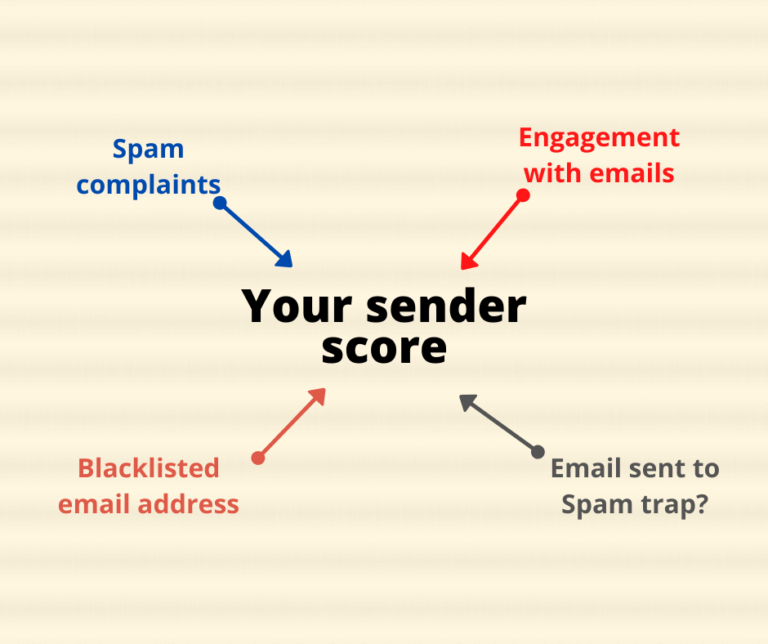
You should therefore send your cold emails exclusively to those who seem interested in what you have to say. You don’t have much influence over choosing your email recipients or the caliber of contacts if you purchase an email database from a third-party company.
Your sender reputation may suffer significant harm if many of your emails are returned as undeliverable or ignored. That’s why we advise you to use opt-in pop-up tools like optinmonster to organically grow your mailing list. Even though it will take some time, your sender’s reputation won’t suffer.
Verify your mailing lists
We’ve already seen that a high number of bounced emails is terrible for your email sender reputation. You can avoid this by using a tool to validate email addresses in your mailing list before sending them emails.
To clean up your mailing list, use a tool like emaillistverify. It will remove invalid, inactive emails, spam traps, and so on, allowing you to send cold emails only to legitimate recipients.
Use a cold email marketing software
If your emails appeared to be manually sent by someone, they would bypass spam filters. To successfully land your emails in the INBOX, you’ll need email automation software that can mimic human-like sending behaviour rather than sending everything all at once.
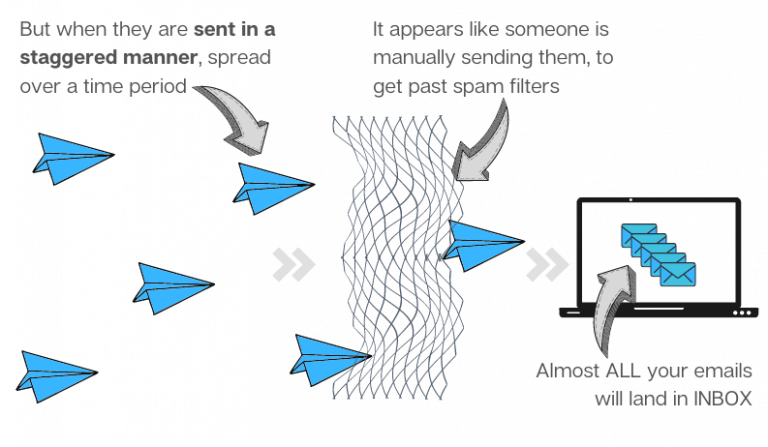
That is exactly what cold email automation software does. It distributes your emails over a period of time. Instead of sending 10,000 emails all at once, spread them out over a few weeks, sending only a few hundred per day.
Furthermore, cold email marketing software sends individual emails at random intervals of a few minutes, just like you would if you sent them manually. This leads spam filters to believe that the emails are being sent manually, so they are not blocked.
You can use SafeMailer to create a cold email automation workflow within Google Drive, allowing you to send cold emails at scale with simple Google Drive Apps. Try it out here.
If you’re wondering how many emails you should send per day, read this. However, it is always best to begin slowly and gradually increase your sending volume.
Mitigate risks by using separate domain for email marketing
Despite all precautions, there is a small chance that some people will mark your cold emails as spam. If that happens, you don’t want it to tarnish your main domain’s sender reputation.
For example, suppose you own the domain www.yourwebsite.com. And you’re sending cold marketing emails from your john@yourwebsite.com account. If a large number of people begin to accuse you of spamming them, your sender reputation will suffer, and even genuine emails to your existing customers will end up in SPAM.
Simply use a separate, disposable domain for your cold email marketing to avoid this risk. So that if the secondary domain gets blacklisted for any reason, you can simply dispose of it without disrupting communication with your current customers.
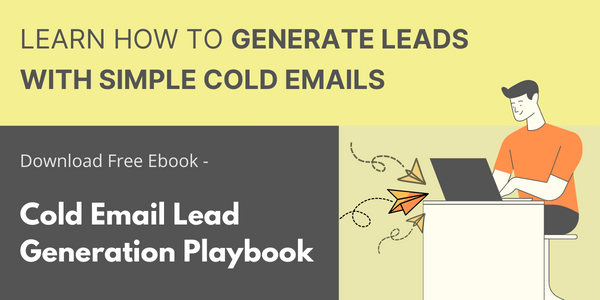
Tips and tactics for writing cold emails
You will be able to land your cold emails in INBOX if you follow the best practices for cold email deliverability outlined in the previous section. The following challenge is getting people to open, read, and respond to your cold emails.
With that in mind, let’s look at the best practices for writing cold emails.
Subject line
Cold email subject lines are just as important as email copy, if not more so. The subject line of your email will make the first impression on your readers.
They will not open your emails if your subject line fails to pique their interest and imagination. Then, no matter how good your email content is, your cold emails are useless.
To increase engagement, write email subject lines that include one or more of the following elements.
- Personalized email subject ( Hi #Name# )
- Create a sense of urgency ( 50% OFF only for today )
- Build familiarity ( Hey #First Name#, we met earlier at #Event Name# earlier )
- Pique curiosity ( Is your email opening rate better than industry average? )
- Provide social proof ( What # Existing Customer Name# has to say about us ). This one combines curiosity and social proof.
- Establish authority ( Rated #your rating# by Gartner )
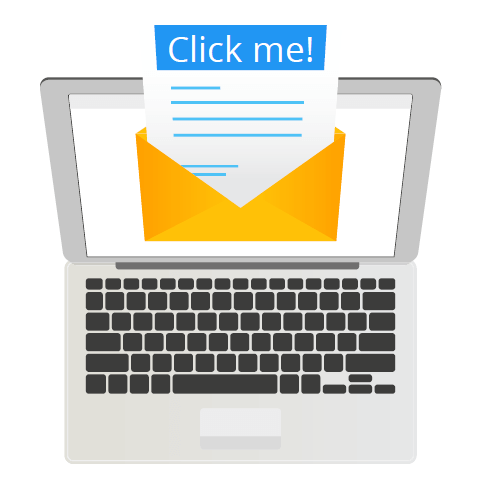
Here’s a more in-depth guide to writing cold email subject lines that will grab someone’s interest.
Cold email content
To get a tangible result from your email campaign, your emails must be engaging by default. Furthermore, when people interact with your emails and write back to you, this will greatly improve your sender’s reputation.
Why does it matter? Because as your reputation develops, you will be able to safely contact more of these people. Low engagement, on the other hand, will harm your sender’s reputation in the long run.
Obviously, it is critical to write emails that provide the reader with something of value. Here are a few best practices for writing a cold email.
- Keep your emails brief, clear and get straight to the point.
- Highlight experience and build trust. Assist your readers in taking your email seriously.
- Build familiarity by touching upon shared interests, mutual acquaintances, events visited etc.
- Concentrate on value rather than features.
- Write a clear, concise Call To Action (CTA) in your email.
- Avoid using certain spam trigger words in your email copy.
- Minimize the number of links and images in your email. High number of links and images can damage deliverability.
- Avoid email attachments if possible.
If you want to explore examples of cold emails, here’s a list of cold email templates for sales.
Add a personalized touch to your emails
Not only will spam filters reject emails that appear to have been written by a robot, but so will your recipients. A warm personal touch, on the other hand, always adds a humane element to your emails, helping you to get better engagement.
Some more best practices to make your cold emails more personal –
- Change your sender name, to your own name + company / brand name (For example – John from SafeMailer)
- Add a signature to your email along with your contact details, a photo and company logo. Not only is this positively viewed by your audience, but also improves the deliverability of your emails.
- Add your own photo to your email account.
- Use a mail merge tool to create highly personalized emails for your audience.

Highlight experience, build trust
If you managed to get your audience to open your emails and read them, you have got their attention. Now is the time to tell them about your products and services.
You can tell them many nice things about how you can help them with their business, but they will not readily take your word on it. Because, remember this is a cold email and they don’t yet trust you.
So focus on building an element of trust with whatever ammunition you have. If you can tell them about your existing customers, how you have helped them and the nice things they are saying about you, it will help you to start building some trust with the recipient.
Here are some things that you can highlight –
- Number of years in the business
- Total number of customers or users
- Big achievements or iconic projects
- Testimonials or references for marquee customers
Mention just one of these key data points. Don’t go overboard by writing a long list. Remember the 5-10 lines rule. Ultimately, your recipients are not interested in knowing all your customers. It will suffice to give them 2 names that they can recognize.
Focus on value, not on features
If you have followed these cold email marketing tips so far, you’ve succeeded in getting your email opened and building a small degree of trust or familiarity.
Now let’s get to the sales pitch.
Some marketers have a habit of throwing a well articulated feature list at everything, even in their cold emails.
But when it’s a cold email, the recipient has not asked about your product features (not an inbound lead). They don’t even know that they need your product!
So your first job is to convince them that you product can benefit them and maybe they really need it. Writing about the possible use cases and benefits will help much more than talking about the features in regular marketing jargon.
Your email should teach them about the possible benefits. Give them a solution to their problems, rather than advertising your product.
Clear ‘call to action’
When you have followed all of these cold email marketing tips, you’ll be able convince your recipients about the value of your products and services or at least make them curious about it.
So while you have their attention, ask them to take a meaningful action to indicate their interest in what you’re selling. Make a clear call to action.
Without a clearly stated call to action, customer can go on about his day and forget about your little email in 1-2 days. So without a call to action, you risk losing all the hard work invested in your cold email.
What action you should ask for depends on a variety of factors like brand recognition, trust factor, average selling price, purchase decision making cycle.
For simpler, cheaper products you can directly give them a link to your online store.
But for more complex and expensive solutions, purchase decision will be made by multiple stakeholders, discussions will take a few weeks. So you can ask your recipients to take the first step in this long sales cycle – ask for a demo or a meeting or even a phone call.
But in any case, make a clear call to action.
Warm up email account and test deliverability
When you want to send cold emails at scale, with or without automation, you will need to first warm up your email account. If you send a few thousand cold emails in the very first week from a new email account, there are very strong chances of your emails landing in SPAM.
Spam filters look at the history of your email account when deciding whether or not to classify your emails are spam. If you only have outgoing email traffic, if majority of your emails are identical and if many people just ignore your cold emails, then there’s a high chance you are spamming them. So spam filters will put your subsequent emails in the SPAM folder.
To avoid this, you will need to first warm up your email account by –
- Subscribing to a bunch of newsletters to get incoming email traffic
- Send a small number of emails initially, gradually increasing the daily number of 4-6 weeks
- Start by having meaningful email exchanges with people you know, to establish some credible email usage history.
After a successful warm up, you should also test the deliverability of your emails before starting any cold email automation campaign.

Leave a Reply